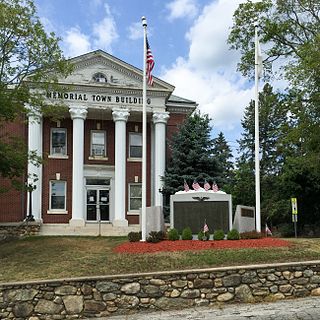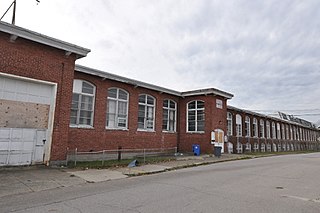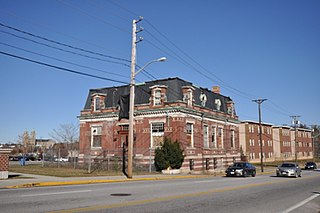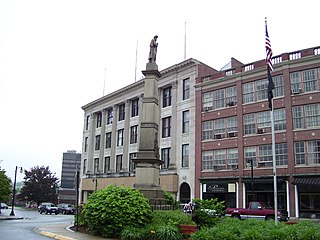
Woonsocket, is a city in Providence County, Rhode Island, United States. The population was 43,240 at the 2020 census, making it the sixth largest city in the state. Being Rhode Island's northernmost city, Woonsocket lies directly south of the Massachusetts state line and constitutes part of both the Providence metropolitan area and the larger Greater Boston Combined Statistical Area.

Wakefield is a village in the town of South Kingstown, Rhode Island, United States, and the commercial center of South Kingstown. Together with the village of Peace Dale, it is treated by the U.S. Census as a component of the census-designated place identified as Wakefield-Peacedale, Rhode Island. West Kingston, another South Kingstown village, was the traditional county seat of Washington County. Since 1991, the Washington County Courthouse has been in Wakefield. The Sheriff's Office which handles corrections is also in Wakefield.

Slatersville is a village on the Branch River in the town of North Smithfield, Rhode Island, United States. It includes the Slatersville Historic District, a historic district listed on the National Register of Historic Places. The historic district has been included as part of the Blackstone River Valley National Historical Park. The North Smithfield Public Library is located in Slatersville.

Saylesville is a village and historic district in Lincoln, Rhode Island.

The Bernon Worsted Mill is an historic textile mill at 828 Park Avenue in Woonsocket, Rhode Island. It is a brick building, two stories tall, about 280 feet (85 m) in length. It was built in 1919 by Charles Augustus Proulx, and was operated as a producer of specialty custom worsted wool yarns, in what was then a sparsely populated part of the city. The building saw somewhat regular use in the manufacture of textiles until 2004.

The Cato Hill Historic District is a residential historic district in central Woonsocket, Rhode Island. It consists of about 2-1/2 blocks of Church and Cato Streets, as well as the streets crossing them. The area, located on a hill just above Woonsocket's downtown area, is a densely populated area built primarily between 1838 and 1875, during Woonsocket's growth as a major textile processing center. Cato Hill is named for Cato Aldrich, an African American who purchased the land from the Arnolds who founded Woonsocket. The houses of the district exhibit vernacular forms of the architectural styles popular in the mid-19th century.

The Glenark Mills or Glenark Landing is a historic textile mill complex on 64 East Street in Woonsocket, Rhode Island. The original stone section of this mill was constructed 1865 by William Norton and was enlarged with a brick addition in 1885. Originally a cotton mill, the building was converted for use as a knitting mill and then as a worsted mill. It was added to the National Register of Historic Places in 1989.

The Island Place Historic District is a historic district at Island Place and South Main Street at Market Square in Woonsocket, Rhode Island. The district includes six historic buildings, three of which are part of the Woonsocket Rubber Company Mill, dating from c. 1857 to c. 1919. The other buildings in the district are the Island Machine Company, the Barnai Worsted Company Dyeworks, and a wood-frame structure, that is the last surviving elements of the Wilkins Manufacturing Company. The district is bounded by Market Square, Bernon Street, and a bend in the Blackstone River. The site is now home to the Museum of Work & Culture, a project of the Rhode Island Historical Society.

The Main Street Historic District is a historic district in the central business district of Woonsocket, Rhode Island, USA. It extends along Main Street, between the railroad tracks just northeast of its junction with Clinton Street, and roughly Ascension Street at the southwest. Most of the sixteen buildings in this area were built at the height of Woonsocket's prosperity, roughly between 1850 and 1930. The district is characterized by brick and masonry buildings generally between two and six stories in height.

Woonsocket Rubber Company Mill is an historic mill at 60-82 Main Street in Woonsocket, Rhode Island. The mill consists of a series of 3- and 4-story brick buildings built between 1865 and 1875 by Edward Harris, one of Woonsocket's leading businessmen. These buildings housed the Woonsocket Rubbert Company, one of Rhode Island's first manufacturer of rubber products, principally shoes, boots, and rubberized fabric. In 1910 the complex was purchased by the Falls Yarn Company, which used it for the production of fine woolen yarns.

The Woonsocket Company Mill Complex is a historic district encompassing one of the largest mill complexes in Woonsocket, Rhode Island. The district includes all of the buildings historically associated with the Woonsocket Company, a major manufacturer of cotton textiles in the 19th century. The complex is located along the eastern bank of the Blackstone River between Court and Bernon Streets. It includes three handsome stone mills, built between 1827 and 1859, and a power plant that was built on the site of the former #3 mill between 1890 and 1920, as well as the remnants of the canal that originally carried water to the buildings for power.

The Philmont Worsted Company Mill is an historic mill building at 685 Social Street in Woonsocket, Rhode Island. The large three-story brick building was erected in 1919 by Joseph and Theofile Guerin, Belgian investors brought to Woonsocket by the promotional activities of Mayor Aram Pothier. Unusually for the Guerins, the mill used the "English system", instead of the French system of their other operations, for the production of worsted wool yarns. The Philmont Company was shuttered by the Great Depression in 1933, but the building was later used by other textile producers until 1955. The building has been converted to residences.

The Oriental Mills are a historic textile mill complex at 10 Admiral Street in Providence, Rhode Island. The site consists of seven buildings, constructed between about 1860 and 1917, by a variety of textile manufacturers that operated on the site. The oldest building, from c. 1860, was built by the Oriental Mills Manufacturing Company soon after its founding. It is a large three-story brick structure, presenting eight bays to Admiral Street and thirty to Whipple Street. It has a well-defined Italianate roof line with brackets. Building 3, which lies southeast of Building 1 and fronts on Oriental Street, is from the same time period and exhibits similar styling. Originally used for the manufacture of cotton textiles, the complex was purchased in 1918 by the American Silk Spinning Company, which pioneered the blending of nylon fibers into its products here.

The Hope Village Historic District is a historic rural mill settlement within Hope Village in Scituate, Rhode Island. Hope Village is located on a bend in the North Pawtuxet River in the southeastern corner of Scituate. Industrial activity has occurred in Hope Village since the mid-eighteenth century. Surviving industrial and residential buildings in the Historic District date back to the early 19th century. The village center sits at junction of Main Street and North Road. Hope Village radiates out from the center with houses on several smaller side streets in a compact configuration. Currently there is little commercial or industrial activity in Hope Village and none in the Historic District. The present stone mill building on the south side of Hope Village was built in 1844 by Brown & Ives of Providence, expanded in 1871 and modified in 1910. Approximately one quarter of the village's current housing stock was built as mill worker housing by various owners of Hope Mill.
The city of Woonsocket in the U.S. state of Rhode Island was established as a union of six mill villages along the Blackstone River. These villages are described in more detail below.

The Jules Desurmont Worsted Company Mill is a historic mill at 84 Fairmount Street in Woonsocket, Rhode Island. The mill complex consists of three brick buildings, erected 1907-10 by Jules Desurmont, the owner of a textile firm in Tourcoing, a city in northern France, who had been drawn to Woonsocket by the promotional activities of Aram Pothier. The mill produced French worsted wool yarn until 1952, and was used for many years thereafter by smaller textile and industrial concerns.

The Naushon Company Plant is a historic textile mill complex at 32 Meeting Street in Cumberland, Rhode Island. First built in 1902-04 and enlarged over time, it illustrates the adaption of the site to differing uses between then and the 1950s, when its use for textile manufacture ended. The complex was listed on the National Register of Historic Places in 1978.

The Rochambeau Worsted Company Mill is a historic textile mill complex at 60 King Street in the Olneyville neighborhood of Providence, Rhode Island. Set between King Street and the Woonasquatucket River, it is a three-story brick-clad steel frame structure, built about 1923. It was the third mill in Rhode Island in which a French system of textile processing was implemented. The business was established in 1922 by the Lepoutre Brothers, French immigrants who had first begun operations at the Lafayette Worsted Company in Woonsocket, and operated until 1956. It was thereafter occupied by the Imperial Knife Company, which operated here until 1987, manufacturing tableware.

The Lafayette Worsted Company Administrative Headquarters Historic District encompasses the two surviving buildings of a once-extensive textile mill complex in Woonsocket, Rhode Island. Located near the Woonsocket Middle School on Hamlet Avenue are a former guest house, built about 1920, and the mill's 1923 administration building, an elaborate Second Empire brick building designed by Woonsocket architect Walter F. Fontaine. The Lafayette Worsted Mill, established in 1900, was one of three major local mills engaged in the French style of worsted wool production. Most of its buildings were demolished in 2008.

The L'Union Saint Jean-Baptiste d'Amerique is a historic building at 1 Social Street in Woonsocket, Rhode Island. Built in 1926, it housed a fraternal benefit society for French Canadian Roman Catholic immigrants for many years, serving a significant immigrant population in the community. The building is also a prominent example of Classical Revival architecture, designed by a French Canadian immigrant architect, Walter F. Fontaine. The building was listed on the National Register of Historic Places in 2018.






















